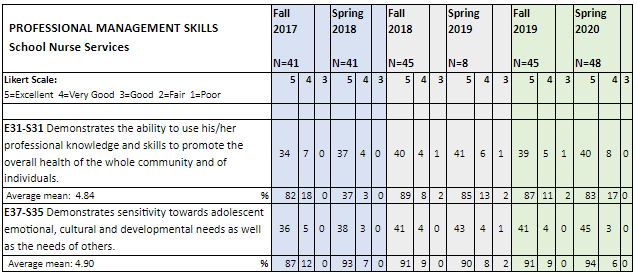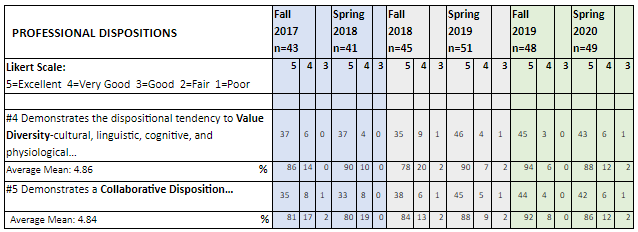AAQEP Accreditation
Standard 1 Aspect C
Standard 1. Evidence shows that by the time of the program completion, candidates exhibit knowledge, skills, and abilities of professional educators appropriate to their target credential or degree, including: Culturally responsive practice, including intersectionality of race, ethnicity, class, gender identity and expression, sexual identity, and the impact of Language (health) acquisition and literacy development on learning (health).
California is a diverse state and most school districts have students from multiple cultural backgrounds with many languages spoken in the classroom. School nurses engage in culturally responsive care by addressing the individual needs of students, families and communities. They promote equal access to school health services, provide interventions and educate other health professionals as to cultural similarities and differences in the school community to advance health related goals. School nurses provide kind and compassionate care, respect differences and consider cultural practices when recommending health interventions. This might involve obtaining translators for medical referrals, parent conferences and health teaching to ensure parent and student understanding and encourage collaboration. The school nurse becomes aware of the home language, customs, foods and belief systems of a student when designing the individualized healthcare plan. Culturally responsive practice also involves partnering with community resources to design and implement policies that ensure cultural and linguistic appropriateness for students and families.
Data Sources & Analysis:
DATA Sources to be Introduced:
- Preceptor Checklist of Skills and Competencies-Professional Management (Form P106/P206)
- Professional Dispositions (Form P104/P204)
- N186 School Nurse Practicum-Key Assignment: (Cross Cultural Special Education Case Study)
- Program Prerequisite: Community Health Nursing GPA 3.00
Data Source 1
Midterm and Final Semester Fieldwork Evaluation, Preceptor Checklist of Skills and Competencies (P106/206) - Professional Management Skills
The first measure is the Fall semester (Elementary) and Spring semester (Secondary) semester Fieldwork Evaluation (Preceptor Checklist of Skills and Competencies-Professional Management Skills, P106/206) used by preceptors to evaluate candidates in their field work knowledge at two points. Candidates are rated on a 5-point Likert scale from 5 “Excellent” to 1 “Poor”.
Perspective: Preceptor
Definition of Success: Our goal is to see positive growth from the fall to spring semesters. The program goal is for all candidates to achieve an Excellent or Very Good rating.
Elements Using:
Items supporting culturally responsive practice include:
- Item 1: E31-S31 "Demonstrates the ability to use his/her professional knowledge and skills to promote
the overall
health of the whole community and of individuals."
Example skills from the preceptor checklist:
-
- E6 - “Correctly identifies relevant community health agencies, services, and programs. Demonstrates leadership ability to assist children and families in accessing appropriate community resources.”
- S9 - “Identifies appropriate programs/services for students/families with special needs/problems (e.g., mental health, family planning needs, prenatal care).
- Item 2: E37-S35 “Demonstrates sensitivity towards adolescent emotional, social, cultural and developmental
needs as well as the needs of others. Identifies the ethnic makeup of the school/district
and provides culturally sensitive care to each child and family.”
Supporting evidence from the skills checklist:
- E19 - “Describes student population in schools and insight into cultural differences. Demonstrates ability to communicate effectively with students and families of different cultural backgrounds.”
SN Professional Management Skills

Summary of Findings
From 2017-2020:
- E31-S31 scores demonstrated 98% of the candidates were rated by preceptors as Excellent
or Very Good and three students ranked Good in the ability to use professional skills
to promote the overall health of the community including cultural areas. Zero percent
of students rated Fair or Poor.
Mean scores for E31-S31 consistently ranged from 4.82 in 2017 to 4.88 in 2020 with an average of 4.84. - E37-S35 scores demonstrate in organizing school health programs including cultural
aspects 99% of candidates in Nursing 187 were rated by preceptors as Excellent or
Very Good in 2019 and 2020. One student received a Good rating.
Mean scores for E37-S35 ranged from 4.87 to 4.93 with an average of 4.90 in the past 3 years.
Analysis and Interpretation
Data demonstrates candidates consistently achieve high ratings for their ability to
provide culturally responsive practice when promoting the overall health of the school
community. Raw data did not show significantly higher scores second semester overall
but remained consistent.
Data Source 2
Professional Dispositions
The second measure is Professional Dispositions. Preceptors are responsible for assessing
candidate ability to competently carry out required skills and competencies in clinical
practice.
Perspective: Preceptor
Rationale for Using:
Professional Dispositions measures behavior needed for successful practice.
Elements Using:
- Item #4: “Candidate demonstrates the dispositional tendency to Value Diversity-cultural, linguistic, cognitive, and physiological (This disposition is critical to the differentiating instruction and creating psychologically and physically safe helping environments”).
- Item #5: “Candidate demonstrates a Collaborative Disposition (The school nurse must collaborate/communicate meaningfully/effectively with other professionals, school site personnel, members of the community and families in order to effectively meet the health care needs of children/professions”).
Definition of Success:
This measure is a 5-point Likert scale with Excellent to Poor ratings. Our goal is
100% of the candidates will measure an Excellent or Very Good on Dispositions.

Summary of Findings
Fall 2017 to Spring 2020:
Standard 4: Preceptors stated 98.9% of candidates achieved an Excellent or Very Good rating
demonstrating the tendency to Value Diversity. Three candidates received a Good rating
and zero percent of students received a Fair or Poor rating.
Mean average for Standard 4 ranged from 4.86 to 4.93 with an average of 4.84.
Standard 5: Preceptors stated 99% of candidates demonstrated a Collaborative Disposition with four candidates receiving a Good rating. Zero percent of students received a Fair or Poor rating.
Means for Standard 5 were between 4.79 and 4.91 with an overall average of 4.83.
Analysis and Interpretation
Data demonstrates candidates consistently achieve high ratings for their ability to
provide culturally responsive practice when promoting the overall health of the school
community as defined by the candidates demonstrating “Value Diversity” and “Collaborative
Dispositions”. Raw data did not show significantly higher scores second semester overall
but remained consistent.
Data Source 3
N186 School Nurse Practicum I-Key Assignment: (Special Education Cultural Case Study)
Nursing 186 is a practicum course allowing school nurses to place a major focus on
the impact of culture on students, family, and community.
Perspective: Program faculty
Rationale for Using:
Although diversity and cultural areas are addressed in Nursing 137, Nursing 184, and
Nursing 186, the major assignment addressing cultural areas is the Cross Cultural
/Special Education Study. The subject of the case study must be a special education
student in a culture outside of the candidates own. The candidate explores cultural
impact on health beliefs and practice. The purpose of this assignment is two-fold:
- to gain a broader perspective and more in-depth understanding of the SST (Student Study Team)/ IEP (Individual Education Plan) assessment team
- to strengthen cultural understanding
Definition of Success: Candidates are expected to achieve an 80% or a “B” grade in Nursing 186 to achieve this measure.
Grades in courses focusing on culturally responsive practice:
| Mean GPA | 2017 | 2018 | 2019 | Mean GPA Combined |
|---|---|---|---|---|
| Nursing 137-Teaching Strategies | 3.86 n=35 |
3.89 n=45 |
3.89 n=35 |
3.88 |
| Nursing 184-School Nurse Seminar I | 3.71 n=47 |
3.79 n=52 |
3.92 n=48 |
3.04 |
| Nursing 186-School Nurse Practicum I | 3.83 n=51 |
3.84 n=51 |
3.94 n=49 |
3.87 |
| Nursing 187-School Nurse Practicum II | 3.93 n=44 |
3.88 n=51 |
3.94 n=50 |
3.91 |
Grades for Cross-Cultural Special Education Case Study
| Mean GPA | 2018 | 2019 | 2020 | Combined GPA |
|---|---|---|---|---|
| Cross-Cultural SPED Case Study Assignment | 93% n=51 |
98.6% n=51 |
97.3 n=49 |
96.3=A |
Summary of Findings
Mean GPA data scores in Nursing 186 ranged from 3.83 to 3.94 with a combined mean
of 3.87. Candidates across all cohorts and courses performed at high levels with
mean grades of 3.00 in all courses demonstrating acquisition of knowledge related
to culturally responsive practice. Candidates achieved high marks in the Cross-Cultural
Special Education Case Study Assignment.
Analysis of Standard 1c Findings
According to the evidence provided from preceptors and the candidate’s GPA, the School
Nurse Services Credential program prepares students to be culturally responsive including
intersectionality of race, ethnicity, class, gender identity and expression, sexual
identity, and the impact of Language (health) acquisition and literacy development
on learning (health).
Data presented shows the school nurse has the skills to collaborate, communicate meaningfully and effectively with other professionals, school site personnel, members of the community and families to effectively meet the health care needs of children/professions.
Students demonstrate leadership and the ability to use professional knowledge, skills, and ethical decision making to promote the overall health of the school community and of individuals taking into account all forms of diversity. Candidates achieved high marks in valuing diversity and demonstrating the value of collaboration with all members of the school community including students, families and staff. This is critical to the differentiation of instruction and creating psychologically and physically safe helping environments.